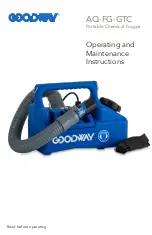
Prism Hammock User Guide
Rev 6 - Feb 2015
page 2
©
P
rism
Me
dical UK
2
01
5
Prism Hammock Sling
Application
The Hammock Sling provides maximum support to the sacral area and is used in
cases where the
Universal Sling
is unsuitable because the individual has poor lower
body tone. It can be used to transfer from the seated to recumbent position or from
recumbent to seated. The person must be assessed by a competent person who
must be fully trained in the suitability, application and fitting of the sling. Carers
should always be trained in the use of hoists and slings.
This sling is usually used in a divided leg position however can be used in a cross
over position for amputees or other people following an accurate risk assessment.
Sling Inspection
All Prism slings are manufactured to meet and exceed the requirements of
BS EN 10535:2006 ’Hoists for the transfer of disabled persons– Requirements and
test methods’. Slings should be inspected prior to use and after washing. Damaged
or badly worn slings should be discarded… The label on the sling contains vital
information to identify the sling - if any part of the label becomes illegible, then it
must be removed from service and replaced.
The sling should be visually inspected with regard to the following items:-
Any signs of damage (i.e. cuts, frays, tears, burns) to the sling straps
Any signs of stitching becoming undone on any part of the sling
Any signs of the fabric being stretched, tearing or undue wear
Any signs of discolouring or bleaching on the material
Is the sling complete? i.e. all straps present, stiffeners in place - where
applicable, etc
Label clearly legible
Compatibility
The issue of sling compatibility with various manufacturers’ hoists has been a
concern for specifiers for a number of years, an issue that is compounded by the
increased number of companies supplying hoists and slings.
Some hoist/sling manufacturers will state that only slings manufactured by them can
be used on their hoists and vice versa. This is their policy only and is
NOT
a legal
requirement. A risk assessment must still be completed even if the same
manufacturer of hoist and sling are to be used, and the specifier simply has to state
that the carry bar is of a similar design and that the sling manufacturer has au-
thorised its use on it.
A comprehensive list is available separately and your local agent will be able to
provide assistance with compatibility issues.
Maximum Load (Safe Working Load - SWL)
The maximum load for the sling is clearly marked on the label of the sling. The
maximum load will also be displayed on the hoist and any detachable elements of
the hoisting system.
DO NOT exceed the maximum load stated on any of the equipment.
Prism Hammock User Guide
Rev 6 - Feb 2015
page 3
©
P
rism
Me
dical UK
2
01
5
A
B
C
D
E
LF1
LF2
Child
640
670
115
450
105
245
200
Junior
750
850
150
580
120
310
240
Small
850
950
160
630
160
310
350
Medium
960
1060
185
700
175
370
360
Large
1050
110
200
700
200
390
430
X Large
1180
1180
250
730
200
400
495
Sling Dimensions
A
C
D
E
LF1
LF2
B
All dimensions have a tolerance of +/- 20mm
Note : All slings are available either with or without Head Support

























